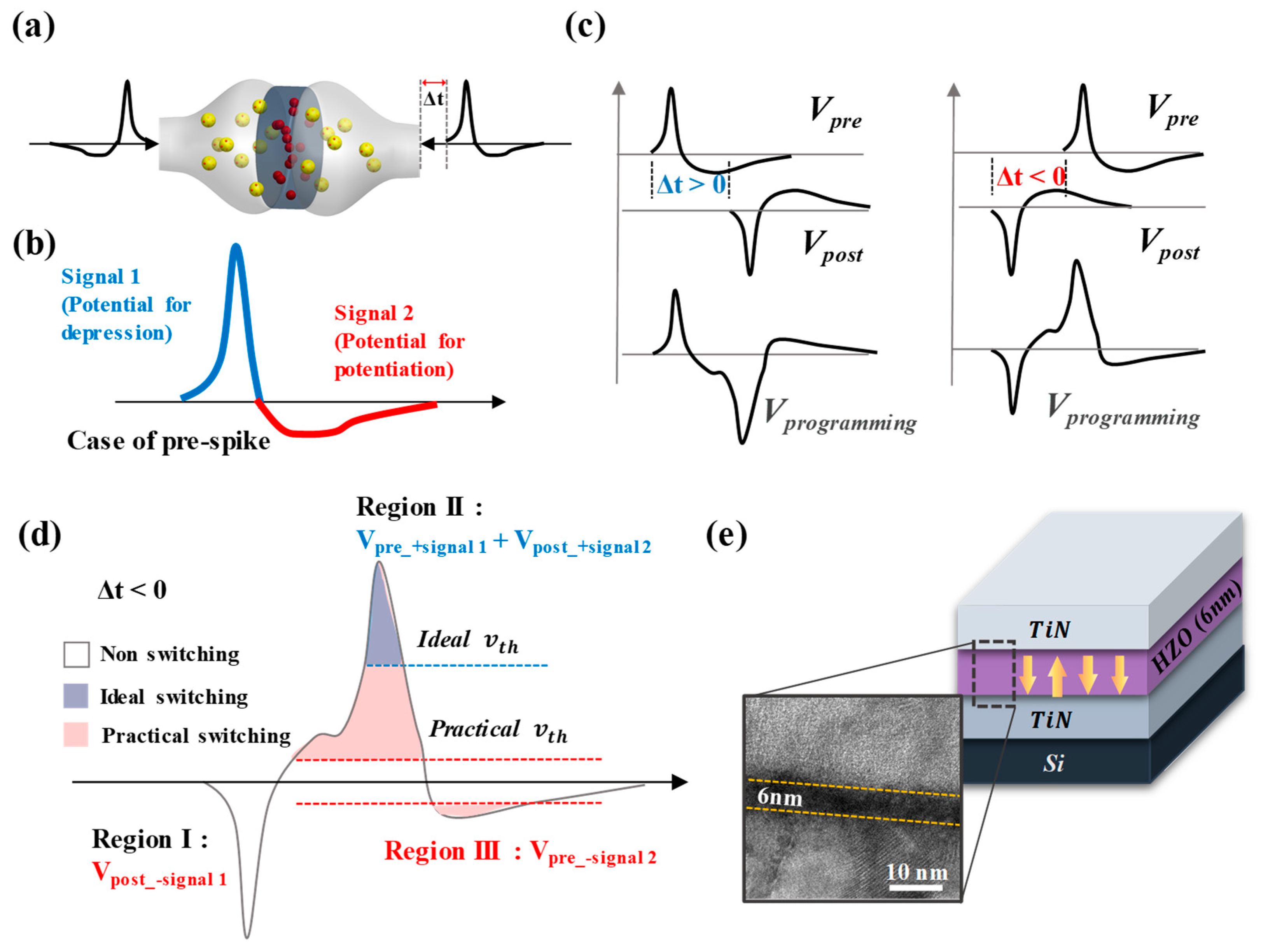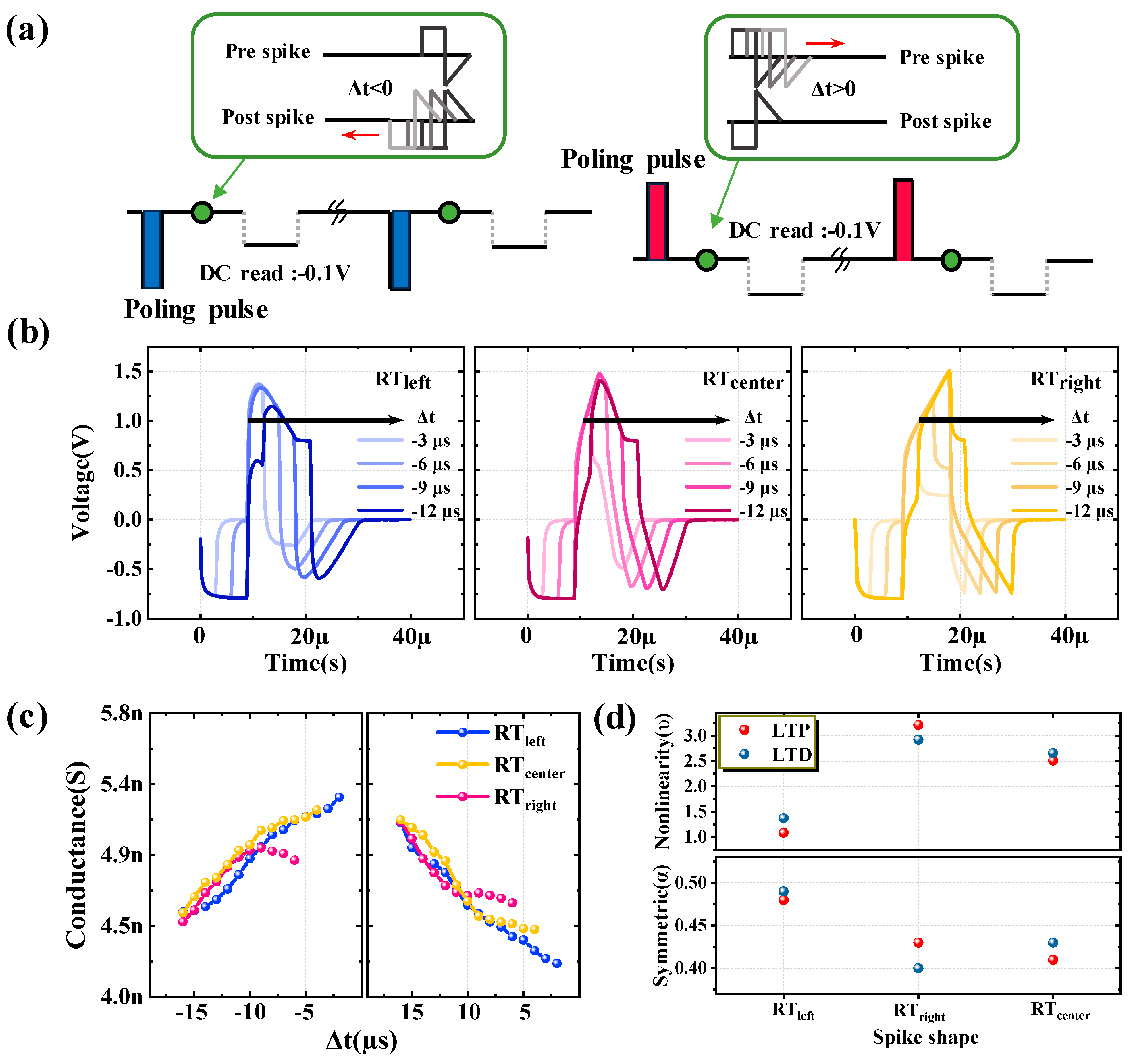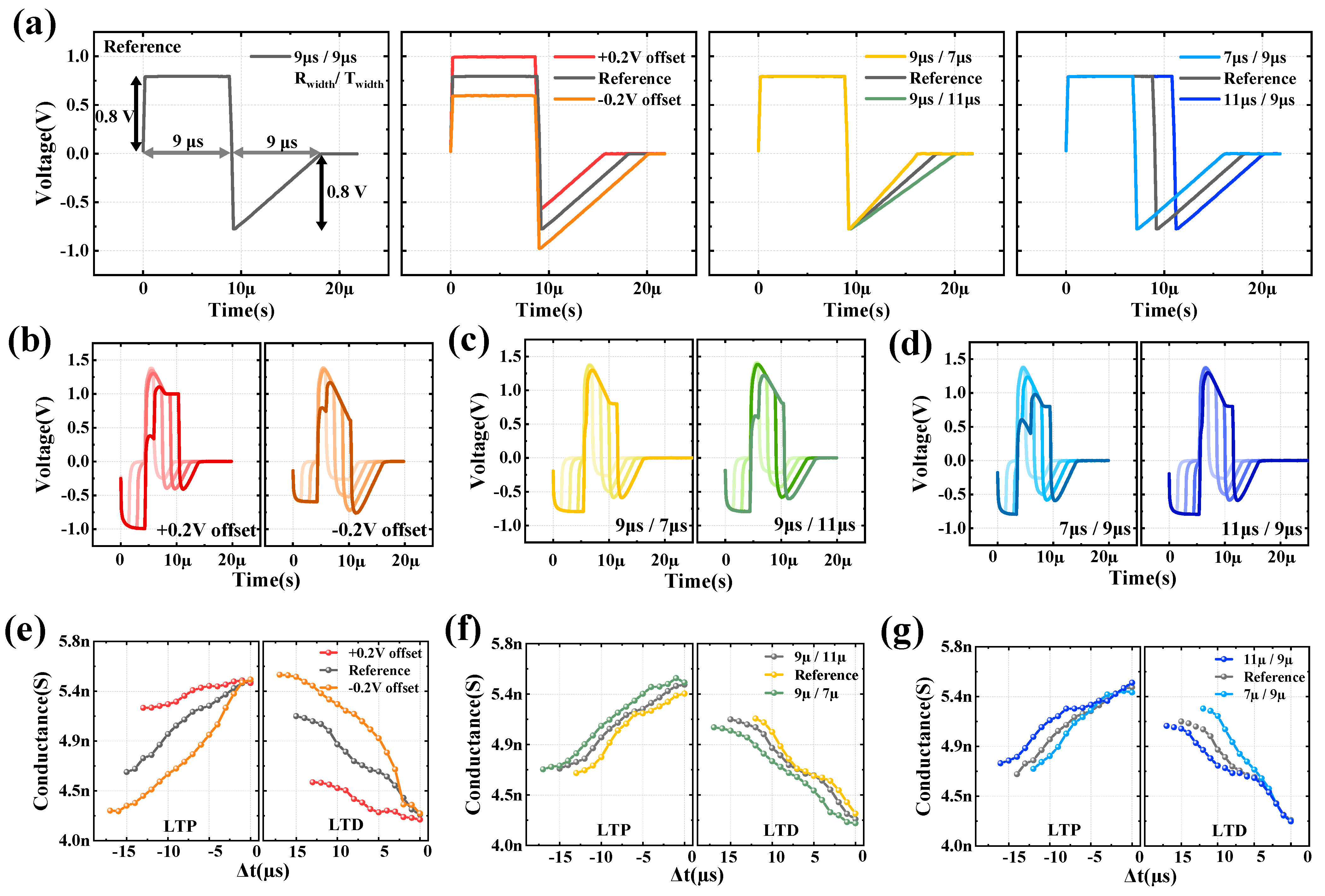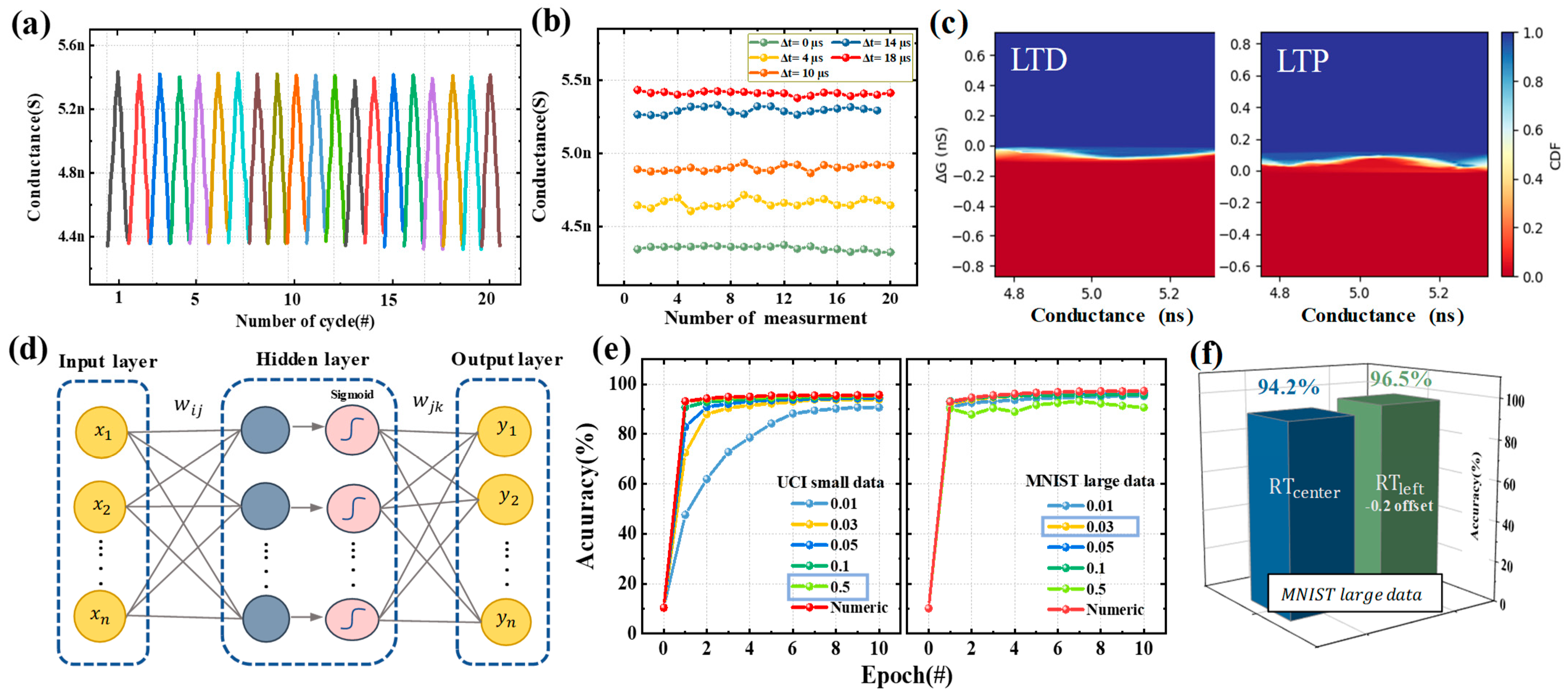2. Results and discussions
In STDP learning of an artificial synapse device, the synaptic weight can be regulated by the overlap of voltage signals applied to both ends of the synapse devices (
Figure 1a).[
14,
15,
16] When the spike is applied to the sample, the post-spike applied to the bottom electrode takes on an inverted version of the pre-spike shape. Since the synaptic weight changes according to the temporal correlation of the signals applied to the synapse device, i.e., pre- and post-spike, the condition of the spike applied to the synapse device has a major impact on the STDP learning result [
17]. In this case, the pre- and post-spike are signals of the same condition, and the spike used for STDP learning usually has the form of two voltage signals of different polarities in succession, as shown in
Figure 1b. [
18,
19,
20] Assuming that a voltage signal of positive polarity is likely to induce depression, a negative voltage signal of opposite polarity is likely to induce potentiation. Since pre- and post-spikes are the same shape of spike but are applied to both ends of the synapse device, the polarity of the pre- and post-spike applied to the synapse is opposite to each other. Assuming that
Figure 1b is the voltage signal of the pre-spike, the post-spike is applied in the opposite order to the pre-spike, in a signal sequence that is likely to induce potentiation and depression. To facilitate analysis, we define the voltage signal of a pre-spike as a combination of V
pre_+signal 1 and V
pre_-signal 2, while the voltage signal of a post-spike received by the synapse is composed of V
post_-signal 1 and V
post_+signal 2. Since the pre- and post-spikes are identically shaped spikes, V
pre_+signal 1 and V
post_-signal 1 are signals of the same condition with only the polarity reversed. In a biological system, a single spike alone cannot induce a change in synaptic weight. However, when there is a temporal correlation between pre- and post-spike signals, as depicted in
Figure 1c, it becomes possible to induce synaptic weight changes such as potentiation and depression[
18]. Potentiation and depression induced when Δt > 0 and Δt < 0, respectively, where Δt represents the time difference between the pre-spike and post-spike. Δt > 0 indicates that the pre-spike is applied more rapidly than the post-spike, while Δt < 0 indicates the opposite. The induction of potentiation and depression can be easily understood from
Figure 1c. When Δt > 0, an overlap of signals occurs between the pre- and post-spike, enhancing the potential to induce potentiation (V
pre_-signal 2 and V
post_-signal 1). Consequently, a signal with a higher amplitude is applied compared to a single spike, resulting in potentiation. Conversely, when Δt < 0, the post-spike is applied more rapidly than the pre-spike, leading to an overlap of signals that have the potential to induce depression (V
pre_+signal 1 and V
post_+signal 2). In this case, depression can be induced. When Δt has different polarities and the same absolute value, it can be inferred that all conditions, except for the polarity of the overlapped spike, are the same. Additionally, when Δt = 0, the same spike is applied with opposite polarities, resulting in complete cancellation, making it impossible to induce potentiation or depression.
To achieve excellent learning results in STDP, it is essential to analyze the overlapped programming spike formed by two single spikes and optimize the conditions of the single spike.
Figure 1d illustrates an arbitrary programming spike when Δt < 0. The programming spike consists of three voltage signals with different polarities presented in succession, and it can be divided into three regions based on the polarity transition, labeled as Region I, II, and III. In an artificial synapse device, the voltage signal amplitude required to induce weight changes is referred to as the threshold voltage (V
th). In an ideal artificial synapse device, the threshold voltage (ideal V
th) is set to be equal to or greater than the maximum amplitude of a single spike. Consequently, when a single spike is applied to the device, the weight remains unchanged due to the threshold voltage being higher or equal to the maximum amplitude of the single spike.[
18] To induce weight changes, amplification of amplitude must occur due to the temporal correlation between pre- and post-spikes. Consequently, ideally, Region I and Region III, where no amplification of amplitude occurs, do not significantly influence the weight. Therefore, STDP learning based on artificial synapse devices has been studied by applying poling signals with the opposite polarity of Region II before applying the spike, enabling the evaluation of weight change induced by Region II.[
21,
22,
23] However, the threshold voltage of memristor devices, which are under investigation for application as artificial synapse devices, is generally very low.[
21,
24] Thus, if the threshold voltage of a memristor device is set to the maximum amplitude of a single spike, the amplitude of the programming spike is not amplified enough to induce a resistance state change even when the two spikes are overlapped, and the number of weight states that can be represented is greatly reduced. To address this issue, when pre- and post-spikes overlap and cause amplification, the amplitude of the single spike must be set sufficiently high to induce substantial changes in the memristor's state. However, when the amplitude is set to a large value, a significant discrepancy arises between the ideal threshold voltage and the practical threshold voltage, which is set equal to the maximum amplitude of a single spike. The blue and red dotted lines in
Figure 1d schematically represent, respectively, the ideal and practical threshold voltages. The amplitude of the single spike exceeds the practical threshold voltage, allowing voltage signals in Regions I and III to also surpass the memristor's threshold voltage, thereby potentially inducing changes in its state. However, as previously mentioned, STDP learning is conducted by applying a poling signal with the opposite polarity to Region II in advance. Consequently, Region I, which has the same polarity as the poling signal, does not affect the state of the memristor. On the other hand, Region III is applied after the memristor's state has been changed by Region II, thereby potentially influencing the memristor's state. As a result, it becomes essential to consider both Region II and Region III when configuring the spike condition to facilitate STDP learning effectively. The HZO-based FTJ used in this study is driven by a tunneling mechanism through a 6 nm-thin ferroelectric HZO layer (
Figure 1e), making it a suitable device for an artificial synapse device capable of high-density and low current operation. It also has the advantage of having a top-electrode, analog multi-state ferroelectric, bottom-electrode structure that can easily mimic the pre-spike, synaptic weight, and post-spike of biological STDP learning. STDP learning is performed by applying the same spike to the top and bottom electrodes while modulating Δt, and the programming spike applied to the HZO varies accordingly, making it possible to express multiple resistance states.
To define an appropriate amplitude for the single spike in the HZO-based FTJ device, polarization-voltage and resistance-voltage measurements were conducted. The polarization-voltage curve (
Figure 2a inset) obtained by applying a triangle pulse with an amplitude of ±1.6 V shows that all polarizations are switched and saturated at 1.6 V.
Figure 2a illustrates the change in resistance state with varying amplitudes of the applied pulse. A poling pulse of negative polarity was applied in advance, the resistance state was measured by sequentially increasing the programming pulse from 0 V to 1.6 V in an interval of 0.1 V. The read voltage was set to 1 V DC bias. It can be seen that the resistance state is almost saturated at 1.6 V, as shown in the inset of
Figure 2a.
Based on these findings, the maximum amplitude capable of inducing transitions from high resistance state (HRS) to low resistance state (LRS) (and vice versa) was set to ±1.6 V. Therefore, to ensure that the maximum state change occurs when both spikes are optimally reinforced and to minimize the range of states that can be modulated by a single spike, the maximum and minimum voltage amplitudes for the single spike were set at an absolute value of 0.8 V. For instance, in the case of the pre-spike, Vpre_+signal 1 and Vpre_-signal 2 were set to 0.8 V and -0.8 V, respectively.
To optimize the spike condition, we considered various combinations of 2 voltage signals, including rectangle, trapezoid, exponential, and three types of triangles (left, center, right peak). Each pulse condition was set to have a pulse width of 9 μs as shown in
Table 1. To ensure the sufficient charging of the ferroelectric capacitor, the width of signal 1 has been set longer than the RC time. The programming spike shown in
Figure 2b represents a scenario where Δt is -9 μs, leading to maximal reinforcement of both pre- and post-spike and inducing the most significant depression among all spike conditions. In all cases, Region I, II, and III exhibit negative, positive, and negative polarities, respectively. As previously mentioned, Region I, which has no influence on state changes, was excluded from the analysis. To achieve multi-state capabilities, a large memory window and gradual state changes are required. First, to enlarge the memory window, Region II should be capable of inducing sufficient resistance state changes while minimizing the resistance state changes by Region III. Also, to achieve gradual state changes, the applied signal should be changed gradually. In the case of the STDP learning method, region II is produced by overlapping V
pre_+signal 1 and V
post_+signal 2, which induce depression in the pre- and post-spike, and region III is produced by V
pre_signal 2, which induces potentiation in the pre-spike. Therefore, to achieve an ample memory window and gradual state changes, it is advantageous to employ a pulse with a stable amplitude, sustained for an appropriate duration in V
pre_+signal 1. Simultaneously, a pulse with a gradual amplitude change should be applied to V
pre_-signal 2.
Figure 2c shows the resistance state change measurement for 5-type pulses for the V
signal 1 setting. Since this is an evaluation of the effect of a single pulse, a pulse under the same conditions as the pulses in
Table 1 used for the spikes in
Figure 2b, the amplitude was set to 1.6 V for all. The results show that the rectangular pulse induced the most resistance state change from about 280 MΩ to about 220 MΩ, which highlights that the rectangle pulse shape is the most suitable for V
signal 1. Upon setting V
signal 1 as a rectangle pulse, it is reasonable to anticipate that V
signal 2 would require a pulse with a gradual amplitude change, making the triangle pulse a suitable candidate. Consequently, the suitable pulse shape for V
signal 2 is expected to be the triangle pulse. With V
signal 1 fixed as a rectangle pulse, we proceeded to conduct STDP measurements by applying 3 types of triangle pulses (left, center, and right peak) as V
signal 2. The spike configurations used are as follows: rectangle - left peak triangle (RT
left); rectangle - center peak triangle (RT
center); rectangle - right peak triangle (RT
right). The pulse conditions used in this experiment are identical to those listed in
Table 1.
Figure 3a illustrates the measurement sequence of STDP learning, with RT
left spike used as an example. The sequence remains identical for all three spike types, proceeding as follows: For cases where Δt decreases in the negative direction from 0, the order of events is poling pulse of negative polarity, pre-spike & post-spike, followed by DC read; the interval of Δt is -1 μs. For cases where Δt increases in the positive direction from 0, the order of events is poling pulse of positive polarity, pre-spike & post-spike, followed by DC read; the interval of Δt is +1 μs. The Δt values are restricted within the range of -18 μs to +18 μs to ensure temporal correlation between pre- and post-spike. During each programming spike, the device's state modified by the spike is measured as current data under a DC bias of -0.1 V. Regarding the 3 types of spikes, RT
left, RT
center, and RT
right, the actual programming spike shapes applied to the HZO layer can be observed in
Figure 3b. Here, Region I is not considered because it does not affect the state and has the same shape for all three types of spikes. First, for the spike RT
left, it can be observed that at Δt = -3 μs and -6 μs, Region II inducing potentiation has the highest amplitude, and as Δt increases, the amplitude sequentially decreases. Simultaneously, at Δt = -3 μs, Region III inducing depression has the lowest amplitude, and as Δt increases, the amplitude sequentially increases. Therefore, it is expected that at Δt = -3 μs, the induction of potentiation will be the highest, and a linearly smaller amount of potentiation is induced as Δt increases. Next, when the spike is RT
center, it can be observed that as Δt increases, the amplitude of Region II is nearly similar to that of RT
left, while the amplitude of Region III sequentially increases. On the other hand, for the spike RT
right, as Δt increases, the amplitude of Region II continuously increases, and the amplitude of Region III remains almost similar. Therefore, it is expected that a larger number of states can be obtained in the order of RT
left, RT
center, and RT
right.
Figure 3c presents the results of the STDP measurements for each spike condition. The conductance change curve due to potentiation (long-term potentiation, LTP) is plotted when Δt > 0, and the conductance change curve due to depression (long-term depression, LTD) is plotted when Δt < 0. For each spike condition, only data in the region where a linear change in conductance occurs were plotted.
LTP and LTD characteristics were analyzed within the same conductance range, and it can be seen that RTleft, RTcenter, and RTright exhibited 14, 13, and 6 distinct states, respectively. Notably, RTleft spike demonstrated the highest number of states, indicating that this particular spike condition induced the most significant diversity in conductance levels. The linearity and symmetric characteristics of weight update (LTD and LTP) in the artificial synaptic device were analyzed using the Symmetric Nonlinearity model.
Linearity and symmetric characteristics are required to achieve high learning accuracy in pattern recognition simulation to evaluate artificial neural networks, and were analyzed by fitting the following equations (Equation 1-3):[
25]
The meaning of each term used in Equations (1-3) is as follows: G
max is the maximum conductance in the LTD and LTP characteristic curves; G
min is the minimum conductance; α is a parameter that can evaluate symmetry; υ is a parameter that can evaluate nonlinearity. α serves as the symmetric center of the LTD and LTP characteristic curves and can take values between 0 and 1. A value closer to 0.5 indicates more symmetric characteristics. On the other hand, υ is used to assess nonlinearity and can take values between 0 and 10, with a value closer to 0 indicating more linear characteristics. The α and υ parameters for each spike can be seen in
Figure 3d. Among the three spikes, RT
left showed the most outstanding symmetric characteristics with α values of 0.48 for LTP and 0.49 for LTD, and the best linearity characteristics with υ of 1 and 1.4, respectively. Considering the number of states, symmetric, and linearity characteristics together, it is evident that RT
left is the most suitable spike shape for the artificial synaptic device.
To optimize the RT
left spike, the STDP learning was conducted by varying the spike's offset, R pulse width, and T
left pulse width. As shown in
Figure 4a (first), the conditions of the reference spike were set with square and triangular waveforms having peak values of 0.75 V and pulse widths of 9 μs each. The spike modulation conditions were as follows: the offset of the spike was adjusted to -0.2, 0, and +0.2 V (
Figure 4a (second)); the R pulse width was set to 7, 9, and 11 μs (
Figure 4a (third)); and the T pulse width was set to 7, 9, and 11 μs (
Figure 4a (fourth)). In contrast, the amplitude in Region III undergoes a considerable variation, extending to a larger range of values. Conversely, when the offset is +0.2 V, the trends observed are opposite to those seen when the offset is -0.2 V.
In this case, the amplitude in Region I, which does not influence the state, increases, while the amplitude in Region II shows no significant variation. Additionally, the amplitude in Region III undergoes a smaller range of change. The offset modulation case showed the most dramatic applied programming pulse shape change, while the pulse width modulation case showed no significant amplitude change in each region as shown in
Figure 4c and d. The measurement results for
Figure 4b-d are plotted in
Figure 4e-g. As expected, the most dramatic changes were seen when the offset was modulated, with the offset of -0.2 V having the highest number of states of 18. In addition, when the linearity and symmetry characteristics were checked in the same way as in
Figure 3c, the case with offset -0.2 V showed the most symmetrical and linear characteristics with α = 0.48 and υ = 1.65. Therefore, considering the number of states, symmetry, and linearity characteristics, the condition with R width of 9 μs, T width of 9 μs, and offset -0.2 V has the best synaptic characteristics. In
Figure 4b, the programming spike shapes for each spike condition are presented. It is essential to pay attention to the results obtained when varying the spike's offset, particularly when the offset is -0.2 V. The amplitude in Region I, which is known not to influence the device state, decreases, while the amplitude in Region II remains relatively unaffected.
Based on the optimized spike conditions, the obtained data was used to perform artificial neural network simulations using the CrossSim simulator provided by Sandia National Laboratories. [
26,
27,
28]. The CrossSim simulator is composed of a neural core that converts the input measurement data into pixel brightness and a digital core that computes the weights. The simulation utilized the measurement data obtained from 20 repeated STDP learning experiments with the optimized spike conditions. (
Figure 5a). This allows pattern recognition simulations to be performed on handwritten digit datasets provided by UCI and MNIST using the CrossSim simulator. However, due to the difference between the range of weights obtained from measurements and the range of conductance stored in the crossbar, the measured data needs to be transformed into a format called the Look-up table to be applied to the CrossSim simulator. [
29] The Look-up table represents the ΔG-G data, which indicates the conductance state change (ΔG) that occurs when an additional signal is applied to the current device's conductance state. This table takes into account various non-ideal factors, such as write noise, read noise, and nonlinearity. In
Figure 5b, the cumulative distribution function (CDF) represents the update characteristics of complex conductance states, which includes non-ideal features reflected through the Look-up table.
Figure 5c is a schematic of an artificial neural network consisting of an input layer, a hidden layer, and an output layer, and the circled parts of the network are called neurons or nodes.[
30] Learning in a neural network refers to the process or algorithm of modifying the weights of neurons that constitute the network.[
31] The learning process follows the following steps:
① The pixel brightness values of the UCI and MNIST handwritten digit datasets are input into the input l; ② The pixel brightness is multiplied by the conductance (G) obtained from the Look-up table, resulting in a summation of values according to Kirchhoff's current law, which is then output to the hidden layer.; ③ The value input to the hidden layer is multiplied by the conductance (G) and the summed value is output to the output layer according to Kirchhoff's current law; ④ The output value is compared with the known image label (the correct answer), and the cost (error) between them is calculated.; ⑤ The internal weights are adjusted in the direction that reduces the cost, aiming to minimize the error during the learning process.
The handwritten digit datasets used in the study are sourced from UCI and MNIST. The UCI small dataset consists of 8x8-pixel handwritten digits and includes 64 nodes, 3,823 training samples, and 1,797 test samples. On the other hand, the MNIST large dataset consists of 28x28-pixel handwritten digits and comprises 784 nodes, 60,000 training samples, and 10,000 test samples. During the training process, each image in the training dataset is used for one epoch, which is considered as one complete iteration of learning.
The accuracy of the neural network at a specific epoch is measured using the test dataset, which is not involved in the learning process and is used solely for evaluation purposes. Before evaluating the pattern recognition accuracy of the artificial neural network based on STDP learning with the optimized spike condition for HZO-based FTJ, the learning rate was optimized. The learning rate plays a crucial role in the learning process, as it determines the step size of weight updates during training. If the learning rate is too small, it may lead to slow learning and hinder the network's performance, or it might get stuck in local minima without reaching the optimal cost. [
32] On the other hand, if the learning rate is too large, it may cause overshooting, where the cost increases instead of converging to the minimum. Therefore, to obtain a suitable learning rate for UCI small dataset and MNIST large dataset, we evaluated the accuracy by learning up to 10 epochs with a learning rate between 0.01 and 0.5, which can be seen in
Figure 5d. The learning rate of 0.5 for UCI small dataset and 0.03 for MNIST large dataset showed excellent pattern recognition accuracy of 95.4 and 96.5%. The red color line in the graph represents the ideal data's accuracy. At 10 epochs, the accuracy achieved with a learning rate of 0.5 for the UCI small dataset and 0.04 for the MNIST large dataset were 95.7% and 97.3%, respectively. These high levels of pattern recognition accuracy can be attributed to the excellent synaptic characteristics achieved through successful spike condition optimization.











